Altered organization of the intermediate filament cytoskeleton and relocalization of proteostasis modulators in cells lacking the ataxia protein sacsin
- PMID: 28535259
- PMCID: PMC5886247
- DOI: 10.1093/hmg/ddx197
Altered organization of the intermediate filament cytoskeleton and relocalization of proteostasis modulators in cells lacking the ataxia protein sacsin
Abstract
Autosomal Recessive Spastic Ataxia of Charlevoix-Saguenay (ARSACS) is caused by mutations in the gene SACS, encoding the 520 kDa protein sacsin. Although sacsin's physiological role is largely unknown, its sequence domains suggest a molecular chaperone or protein quality control function. Consequences of its loss include neurofilament network abnormalities, specifically accumulation and bundling of perikaryal and dendritic neurofilaments. To investigate if loss of sacsin affects intermediate filaments more generally, the distribution of vimentin was analysed in ARSACS patient fibroblasts and in cells where sacsin expression was reduced. Abnormal perinuclear accumulation of vimentin filaments, which sometimes had a cage-like appearance, occurred in sacsin-deficient cells. Mitochondria and other organelles were displaced to the periphery of vimentin accumulations. Reorganization of the vimentin network occurs in vitro under stress conditions, including when misfolded proteins accumulate. In ARSACS patient fibroblasts HSP70, ubiquitin and the autophagy-lysosome pathway proteins Lamp2 and p62 relocalized to the area of the vimentin accumulation. There was no overall increase in ubiquitinated proteins, suggesting the ubiquitin-proteasome system was not impaired. There was evidence for alterations in the autophagy-lysosome pathway. Specifically, in ARSACS HDFs cellular levels of Lamp2 were elevated while levels of p62, which is degraded in autophagy, were decreased. Moreover, autophagic flux was increased in ARSACS HDFs under starvation conditions. These data show that loss of sacsin effects the organization of intermediate filaments in multiple cell types, which impacts the cellular distribution of other organelles and influences autophagic activity.
© The Author 2017. Published by Oxford University Press.
Figures
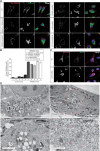
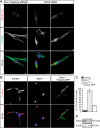

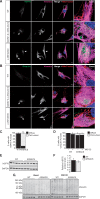

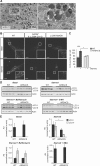
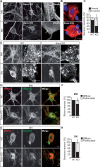
Similar articles
-
Sacsin, mutated in the ataxia ARSACS, regulates intermediate filament assembly and dynamics.FASEB J. 2019 Feb;33(2):2982-2994. doi: 10.1096/fj.201801556R. Epub 2018 Oct 17. FASEB J. 2019. PMID: 30332300
-
Functional Transcriptome Analysis in ARSACS KO Cell Model Reveals a Role of Sacsin in Autophagy.Sci Rep. 2019 Aug 15;9(1):11878. doi: 10.1038/s41598-019-48047-x. Sci Rep. 2019. PMID: 31417125 Free PMC article.
-
A reduction in Drp1-mediated fission compromises mitochondrial health in autosomal recessive spastic ataxia of Charlevoix Saguenay.Hum Mol Genet. 2016 Aug 1;25(15):3232-3244. doi: 10.1093/hmg/ddw173. Epub 2016 Jun 10. Hum Mol Genet. 2016. PMID: 27288452 Free PMC article.
-
Insights into SACS pathological attributes in autosomal recessive spastic ataxia of Charlevoix-Saguenay (ARSACS)☆.Curr Opin Chem Biol. 2022 Dec;71:102211. doi: 10.1016/j.cbpa.2022.102211. Epub 2022 Sep 17. Curr Opin Chem Biol. 2022. PMID: 36126381 Review.
-
Genetics of Autosomal Recessive Spastic Ataxia of Charlevoix-Saguenay (ARSACS) and Role of Sacsin in Neurodegeneration.Int J Mol Sci. 2022 Jan 4;23(1):552. doi: 10.3390/ijms23010552. Int J Mol Sci. 2022. PMID: 35008978 Free PMC article. Review.
Cited by
-
Sacs R272C missense homozygous mice develop an ataxia phenotype.Mol Brain. 2019 Mar 12;12(1):19. doi: 10.1186/s13041-019-0438-3. Mol Brain. 2019. PMID: 30866998 Free PMC article.
-
Driving mitochondrial fission improves cognitive, but not motor deficits in a mouse model of Ataxia of Charlevoix-Saguenay.Res Sq [Preprint]. 2024 Apr 10:rs.3.rs-4178088. doi: 10.21203/rs.3.rs-4178088/v1. Res Sq. 2024. Update in: Cerebellum. 2024 Oct;23(5):2042-2049. doi: 10.1007/s12311-024-01701-1. PMID: 38659734 Free PMC article. Updated. Preprint.
-
The J Domain of Sacsin Disrupts Intermediate Filament Assembly.Int J Mol Sci. 2022 Dec 12;23(24):15742. doi: 10.3390/ijms232415742. Int J Mol Sci. 2022. PMID: 36555380 Free PMC article.
-
AlphaFold predicted structure of the Hsp90-like domains of the neurodegeneration linked protein sacsin reveals key residues for ATPase activity.Front Mol Biosci. 2023 Jan 13;9:1074714. doi: 10.3389/fmolb.2022.1074714. eCollection 2022. Front Mol Biosci. 2023. PMID: 36710881 Free PMC article.
-
Restoring calcium homeostasis in Purkinje cells arrests neurodegeneration and neuroinflammation in the ARSACS mouse model.JCI Insight. 2023 Jun 22;8(12):e163576. doi: 10.1172/jci.insight.163576. JCI Insight. 2023. PMID: 37159335 Free PMC article.
References
-
- Bouhlal Y., Amouri R., El Euch-Fayeche G., Hentati F. (2011) Autosomal recessive spastic ataxia of Charlevoix-Saguenay: an overview. Parkinsonism Relat. Disord., 17, 418–422. - PubMed
-
- Girard M., Lariviere R., Parfitt D.A., Deane E.C., Gaudet R., Nossova N., Blondeau F., Prenosil G., Vermeulen E.G., Duchen M.R.. et al. (2012) Mitochondrial dysfunction and Purkinje cell loss in autosomal recessive spastic ataxia of Charlevoix-Saguenay (ARSACS). Proc. Natl Acad. Sci. U. S. A., 109, 1661–1666. - PMC - PubMed
-
- Engert J.C., Berube P., Mercier J., Dore C., Lepage P., Ge B., Bouchard J.P., Mathieu J., Melancon S.B., Schalling M.. et al. (2000) ARSACS, a spastic ataxia common in northeastern Quebec, is caused by mutations in a new gene encoding an 11.5-kb ORF. NatGenet, 24, 120–125. - PubMed
-
- Anderson J.F., Siller E., Barral J.M. (2010) The sacsin repeating region (SRR): a novel Hsp90-related supra-domain associated with neurodegeneration. J. Mol. Biol., 400, 665–674. - PubMed
Publication types
MeSH terms
Substances
Supplementary concepts
Grants and funding
LinkOut - more resources
Full Text Sources
Other Literature Sources
Molecular Biology Databases
Miscellaneous

